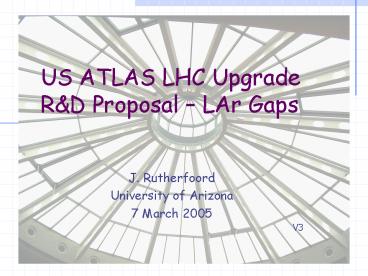US ATLAS LHC Upgrade R PowerPoint PPT Presentation
1 / 14
Title: US ATLAS LHC Upgrade R
1
US ATLAS LHC Upgrade RD Proposal LAr Gaps
- J. Rutherfoord
- University of Arizona
- 7 March 2005
V3
2
Fundamental properties of liquid argon gaps at
high ionization rates
- Work at University of Arizona
- History
- Goals
- Procedure
- Problems encountered
- Proposal
3
History of work at U.Arizona
- Theory Signal shapes in high ionization rate
backgrounds NIM A482 (2002) 156 - Sr(90) source irradiating 110 ?m gap 1991
- Sr(90) source and variable gap - 1995 to present
- Sr(90) source and tube electrodes like in FCal
- Simulations
4
Ionization Rates
Source
Recombination
Critical value
2
4Vo ??
Di
Dr k ? ?-
Dc
a4
- Where Dc is the critical ionization rate in units
of Coulombs/mm3/s - Vo is the potential across the gap
- ? is the dielectric constant for liquid argon
- ? is the positive ion mobility
- a is the gap width
- k is the bulk recombination rate constant
- ?? is the charge density of Ar ions and
electrons
5
First thin gap at Arizona
Source Housing
Sr(90)
25 ?m ss window
Tube electrode
110 ?m gap
6
Variable gap
We vary the source strength the potential
Vo the gap width a We measure the d.c.
current
7
Tube electrodes with Sr(90)
One with 2 mCi and one with 50 mCi Gap is 250
?m Source is 10 mm long
Rod extension
Foil is tucked inside cavity in rod
Tube
Sr(90) deposited on this foil
Completed rod with PEEK fiber
Plug soldered into cavity
8
Computer simulations
- Detailed electron-ion creation, drift, and
recombination in external electric field. - Scaling laws make simulations practical
electron and Ar velocities too different - One set for LHC environment uniform
ionization in gap - One set for Sr(90) source environment
cylindrical symmetry only
9
The goals of the RD
- To determine experimentally the critical
ionization rate - To understand the behavior of liquid argon around
and above the critical ionization rate - To look for unforeseen effects
- Remember that LAr electrodes have never before
been used in such high rate environments
10
Experimental procedure
- Compare
- HV plateau curve with strong sources to
- HV plateau curve with very weak source.
- (Shape of weak source plateau curve is roughly
independent of the gap.)
11
Problems encountered
- At large gap, electron attachment by O2 (and
subsequent recombination) confuses the plateau
curve Can be solved by improved purifiers.
Present best purity is about 0.3 ppm. - At small gap, layer effect confuses the plateau
curve. (See talk at Open Forum
agenda.cern.ch/fullAgenda.php?idaa043926) and
write-up. Is some contaminent gettered onto
the electrodes?
12
Technical point for the experts
- Attachment of electrons by O2 does not
- affect the d.c. current we measure.
- Its the subsequent recombination of the O2- ion
with an Ar ion which reduces the current - My simulations include this effect but the
parameters (mobility of O2- and bulk
recombination rate) are completely unknown. - But using reasonable guesses gives alarming
results.
13
Proposal
- Understand layer buildup effect
- Look for layer buildup in small electrodes (250
?m) and very long runs - Use Gonidec filter and BNL getter
- Perhaps replace cryostat and plumbing
14
Budget
- Engineering Aide 50k
- Misc. parts 15k
- Operations
- Supplies, cryogens, etc. 15k
- Total 80k

